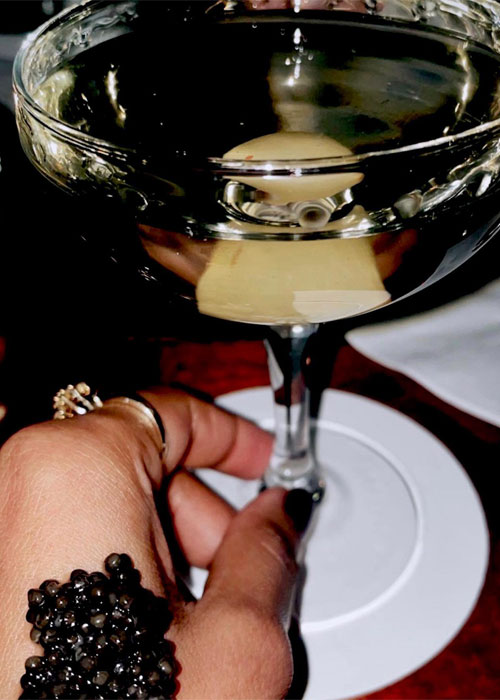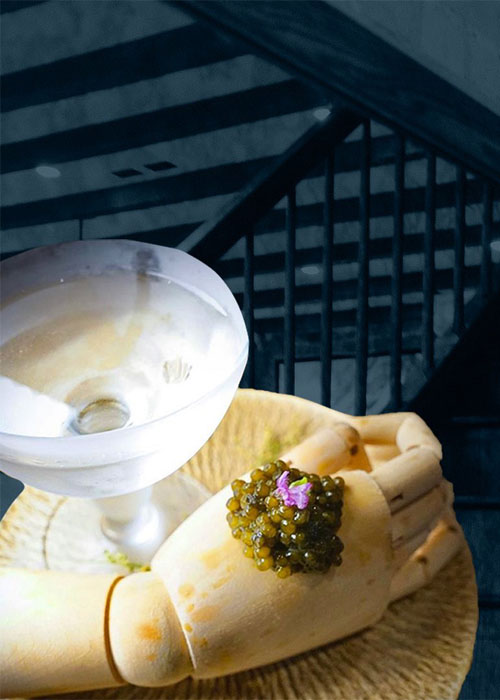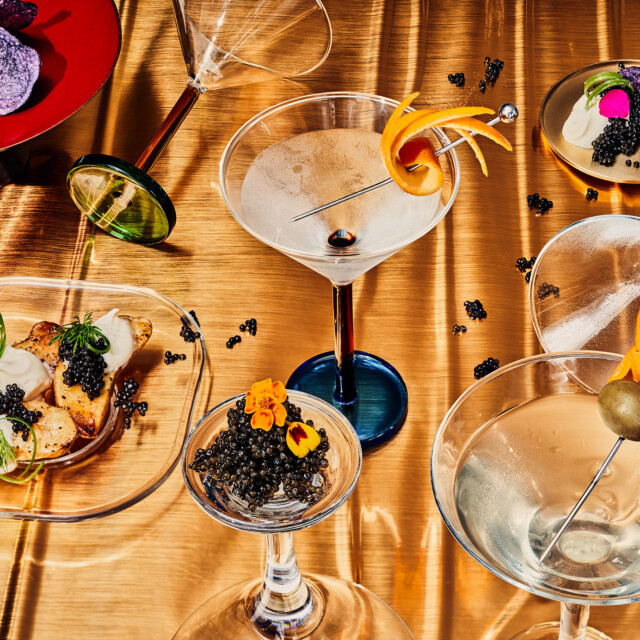The Reserve Martini Tray headlining the menu at Bar Veronika oozes with throwback decadence befitting of its environs, inside the brassily reimagined restaurant of the same name at New York’s palatial Fotografiska Museum. A server in a velvet jacket deposits a Chopin vodka Martini garnished with a crunchy, pickled dwarf peach and accompanied by a baked fingerling potato heaped with crème frâiche and Polish osetra caviar.
“We kind of wanted to go big,” says Eric Alperin, beverage director of Veronika and its parent company CultureWorks. “I think it’s where everybody’s minds are at. We miss that, we miss the party.”
At $35, it’s also fairly approachable. This being Manhattan, Bar Veronika could have easily charged $50, Alperin says, but the goal was accessible decadence in the vein of, “F*ck it, we deserve it,” simply for enduring the past few years. And indulge patrons do, even if it’s not exactly a boon to the bar. Veronika sells around 50 a week — occasionally to duos dropping by simply for a Martini Tray to start their evening.
A Triumphant Return in Uneasy Times
Bringing caviar to (more of) the people — whether spooned on their hands to “bump” in one hedonistic lick or as a Martini accoutrement — has become something of a trend across New York bars. Since Temple Bar reopened in 2021, it has offered a $20 caviar bump with any of the Martinis on its menu. At Gramercy cocktail bar Martiny’s, a pile of Urbani kaluga caviar comes on a wooden mannequin hand wrapped around a miniature Martini ($28). Starting next month at Gen Z exemplar Lullaby on the Lower East Side, an ice-cold glass of house-infused vodka, bearing a Caviar Russe smoked trout roe garnish, joins the menu (price TBD).
“This idea of old-school and Old World opulence has taken the creator community — TikTok and Instagram influencers — by storm,” says New Yorker staff writer and longtime food and drink journalist Helen Rosner. “We can see that with the way [historic Carlyle hotel cocktail bar] Bemelmans Bar is now this unmissably hip place to go for drinks, and in the resurgence of the Martini. It’s this whole notion of an almost caricature-like performance of wealth and luxury without all the nuance that came before the fragmentation of tribal allegiances and social subcultures.”

After all, what’s more glamorous than caviar? The word itself connotes much more than salt-cured, unfertilized fish eggs. It drips with vintage luxury bordering on the obscene — floor-length furs, red lips, and grand hotel bars. For Rosner, the caviar bump’s cringey Rat Pack-meets-“Scarface” decadence also represents a logical step in our cultural trajectory toward excess as we emerge from the pandemic.
It’s also just plain delicious with a clean, spirit-forward cocktail.
“The salinity, savory, and subtle notes of the caviar with a perfect Martini, it doesn’t get too much better than that,” says Takuma Watanabe, co-owner of Martiny’s, which similarly sells about 50 mini caviar Martinis a week. “It’s a luxurious thing that feels like you’re really treating yourself.”
Caviar’s triumphant return this summer coincided with a time of tremendous economic uncertainty; a lingering pandemic, spiking gas prices, and Russia’s war on Ukraine all contributed to a stubborn bout of inflation now threatening to bring about a recession.
Rosner points out that little-ish splurges like caviar Martinis track with spending patterns in past times of financial strain, evoking the so-called lipstick index. During the 2001 recession, then Estée Lauder chairman Leonard Lauder coined the term to describe the surprising increase in lipstick sales that fall, indicating that women facing uncertain economic environments turn to affordable treats like makeup.
“During times of economic hardship people shift the way they spend from big luxuries to little luxuries,” Rosner says. In this case, a $30 caviar Martini at a fancy hotel bar is taking the place of, say, a $1,000 three-Michelin-star meal or a trip to France.
From Wild to Farmed, Beluga to Bowfin — Caviar Ain’t So Exclusive
While not exactly budget-friendly, caviar has come down in price in recent decades thanks to an industry-wide embrace of aquaculture. In turn, this has not only helped lower wholesale prices but to dismantle the notion that true caviar may only come from Russia and nearby countries. For those who prefer their drink and roe choices align with their politics, the emergence of more options affords yet another way to vote with their dollars.
Until just a few decades ago, caviar was mostly harvested from wild sturgeon swimming in the Caspian and Black Seas. Overfishing critically endangered populations, prompting the United States Fish and Wildlife Service and the Convention on International Trade in Endangered Species to enact a series of bans and trade embargoes that made it illegal to sell or harvest wild caviar in the U.S.
This paved the way for farmed caviar, which has become a booming and increasingly sophisticated global industry. As supply ramped up between 2012 and 2019, wholesale caviar prices fell more than 50 percent — though mostly due to cheap Chinese caviar flooding the U.S. market, which caused prices (and much of the product’s historic cachet) to plummet.
North Carolina-based Marshallberg Farm counts among the domestic roe producers trying to siphon customer dollars toward more sustainable, high-quality domestic caviar. Marshallberg raises Caspian Sea-native osetra sturgeon — prized for their nutty, buttery caviar — in a contained indoor farm using a recirculating aquaculture system, meaning 95 percent of the water is recycled. About 95 percent of sales are direct to consumers (starting at $60 per 30-gram tin), with the rest going to high-end boutique hotels and restaurants.
“When everyone was at home on lockdown, our sales went up as people wanted to have special things at home to treat themselves,” says Lianne Won-Reburn, Marshallberg’s quality control and sales manager. Then as restrictions eased, restaurants and bars came calling, ordering in considerable volumes — “more calls and purchases from restaurants getting vendor pricing than we’ve ever had before,” she adds.
Meanwhile, quality, affordable farmed roe from domestic fish like trout, bowfin, and hackleback has gained ground as chefs and bartenders peddle it as a more affordable luxury. Turns out, briny, sweet trout roe inspires almost the same awe as buttery osetra.

“Caviar is a fascinating ingredient to add to our repertoire because it’s so often associated with affluence and is commonly regarded as being incredibly expensive,” says Harrison Snow, Lullaby’s co-owner and beverage director. “Today, however, there are so many types of caviar that are artisanally produced and held to rigorous standards of quality (many of which are cultivated domestically) that are delicious and not nearly as expensive as the super-fancy stuff.”
Pairing it with vodka delicately infused with dill, fennel, cucumber, green peppercorns, and mustard seeds likewise tows the line of Lullaby’s mission to push the envelope for a clientele no longer mystified by Last Words and Negronis at this later stage of the cocktail renaissance. “It allows the drinker to experience the delicate flavors of the base distillate without too much distraction,” Snow says.
“Cocktail education is all over the internet,” he adds. “The palate and drinking preferences of the average consumer has definitely become noticeably more sophisticated over the past two years or so, particularly coming out of lockdown.”
Maybe we are a little more refined. Or maybe we’re all simply seeking an escape and the sort of carnal joy that only comes from this timeless ritual of downing cured fish eggs alongside an ice-cold tipple — drinks budget be damned.
“It’s so reductive to think of food and drink as just what happens when it hits your mouth,” says Rosner. “Especially with something like caviar, there’s a lot of ritual to it, which makes it feel like a special occasion.” Even if you’re taking the highbrow-lowbrow route, eating a “huge f*cking scoop of it” on a potato chip with crème frâiche — her favorite way to eat it, by the way — “the ritual is part of the magic.”
Prop Styling: Maggie DiMarco
Food Styling: Thu Buser
